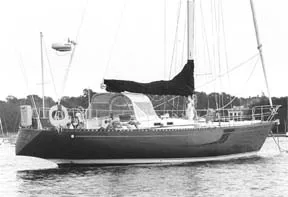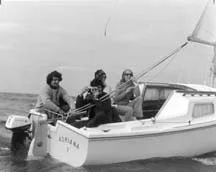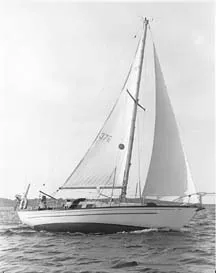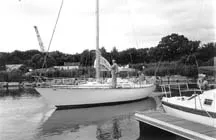It seems our entire boating lives have been spent fixing up junkers. Well, not exactly hurricane boats, but older fiberglass boats that needed a lot of work. Our reasons have been several: We like the older designs for both their looks and construction, low cost, and the opportunity to learn while working. Of course, the last two boats—a 1975 C&C 33 and 1975 Tartan 44—also have functioned admirably as test platforms for Practical Sailor projects.

By way of introduction, the Tartan 44 is a Sparkman & Stephens-designed IOR ocean racer. The hull is the same as the Tartan 41. Former president of Tartan, Charlie Britton, added 3′ to the transom of one of the 41s and actively campaigned Twain, as she was named, in events such as the SORC. The idea was to lengthen the waterline off the wind. She performed well enough that Britton was able to convince seven Tartan buyers to opt for this modification. There was yet another permutation called the Tartan 43, but that is another story.
We bought Viva in December 1993 for $35,000. The hull and deck were sound, and she’d been repowered with a Yanmar diesel engine, but broken portlights had allowed water to damage some teak trim and the cabin sole. Some sails and running rigging had been replaced, but otherwise she was original—meaning “beat.” Major upgrading commenced in the spring of 1994.
Periodically we’ve reported the nature of the jobs, costs and man-hours that have gone into resurrecting Viva. These articles appeared in the October 15, 1995, August 1, 1996 and December 1, 1997 issues. A thorough description of rebuilding Viva’s foam-filled rudder appeared in the January 15, 2000 issue.
Besides the rudder, major work has included replacing four leaky portlights, rewiring AC and DC electrical systems, adding roller furling for the headsail, replacing stanchions and lifelines, replacing all standing and running rigging, compasses, deck hatches, building a ground tackle system with electric Ideal capstan and Delta anchor, replacing the Adler-Barbour ColdMachine refrigeration, buying a rigid Performance Vang, 120-amp Powerline alternator and Link 2000R, painting the topsides with Awlgrip, installing a Dutchman sail flaking system, self-tailing winches, new Seaward propane stove, replumbing the head…oh God, it just goes on!
Cost of all the upgrades had brought our total investment up to about $60,000, nearing the maximum of the boat’s anticipated value on the used boat market. Time to slow down! As spring 1998 approached, it seemed we were nearing the end of the job list, which was heartening.
Besides the aforementioned rudder, other jobs done in the last two years included completion of the new teak cabin sole, installing a Robertson autopilot, beginning work on an inner forestay, installing a Wavestopper hardtop dodger, adding a Raytheon RL 74 Pathfinder LCD radar and pole, and a bunch of miscellaneous, less time-consuming jobs.
Cabin Sole
As noted, water leaks had caused discoloring and delamination to several sections of cabin sole. The principal leaks were broken plastic portlights. These were made by PYHY (now sold by Bomar), long and narrow to barely fit in the side of the Tartan’s blister cabin. What happened is that as the gaskets grew old, previous owners applied increasing pressure to the dogs to get the portlights to seal. Eventually the plastic cracked.
Another leak was discovered in the nylon hose nipple in the polyethylene water tank, under the starboard settee. The aft end of the tank is so close to the nav table bulkhead that a hole had to be drilled in the bulkhead for the nipple. Apparently a slight shifting of the tank caused the crack. Water dribbled down the side of the hull and into the end grain of the sole. Considerable dismantling of the settee was required to remove and replace the fitting. And, of course, the bulkhead hole was enlarged.
We’d already replaced the damaged sole in the saloon, but to make everything match we still had large areas in the galley and aft cabin, and a small section in the forward cabin to do. We bought 4′ x 8′ sheets of 1/4″ teak and holly (actually it’s ash) plywood ($150 each) from Boulder Plywood in Somerville, Massachusetts. The veneer is just 1/25″ thick, so care must be taken in handling. Patterns were made using heavy paper and transferred to the plywood, making an effort to line up the alternating stripes of teak and holly. The various pieces were cut with a saber saw. If you use a fine, new blade, it shouldn’t splinter the veneer. We experimented with scribing the cut line first with a sharp utility knife, which does reduce splintering though the line is so thin it’s hard to see and follow.

Once all pieces were dry fit, the old sole was sanded to remove varnish and dirt. The punky areas were drilled and filled with epoxy and allowed to cure. Then the old sole and undersides of the new pieces were coated with clear epoxy. A mixture of epoxy and filler was troweled onto any low areas. The new sole was set on top the old and weighted just enough to insure contact; too much weight risks squeezing out the epoxy and endangering the bond.
It wasn’t practical to remove the old sole, as it was 3/4″ plywood (with a thicker veneer) and ran under the settees. By covering with new plywood, the entire sole in the boat was raised 1/4″, which required refitting some adjacent solid teak trim, either by rescrewing it higher or cutting off a quarter inch. Loss of headroom in this boat was not an issue.
After the epoxy cured, the new sole was lightly sanded and varnished. Previously we experimented with rubbed effect varnish (reputed to be less slippery) and gloss varnish. We settled on rubbed effect. Unfortunately, we did not know that this type of varnish must be stirred before application. Generally, that’s a no-no. But rubbed effect varnish contains a chemical to knock off the gloss and if not adequately mixed, it causes the varnish to alligator. That’s what happened to us in the forward cabin. This forced us to sand off the varnish and start anew. By the time we figured out our mistake, there wasn’t enough veneer left to take more chances, so we switched to gloss varnish.
Recovering the forward and aft areas of cabin sole took a whopping 47 man-hours! But the improvement in appearance is stunning.
Inner Forestay
The ability to reduce sail in severe weather is critical for any boat. On small boats, this may mean double or triple reefing the main or setting a trysail, and setting a storm jib. On Viva, a better headsail solution is to furl the genoa entirely and set a staysail on an inner forestay.
The critical elements of any inner forestay are the attachment points on the mast and deck. Tim Leary, our rigger, said he could do the mast attachment just above the exit box/sheave for the pole hoist. This left the deck fitting to us.
A common method is to through-bolt matching padeyes to the deck, then install a tie rod or wire cable with turnbuckle between the bottom padeye and a U-bolt glassed into the stem, down around the waterline inside the forepeak. This wouldn’t work on Viva because a big pile of 5/16″ high test chain was in the way.
Bill Seifert, an occasional contributor to PS who worked at Tartan back in the 1970s, suggested fabricating a stainless steel angle beam that would bolt athwartship to the forepeak bulkhead and extend outboard to the hull. The hull-deck joint, he said, is incredibly strong, so if the ends of the beam could run under the joint, it would minimize loads on the 1/2″ bulkhead and deck.
We had a local machine shop bend and weld the beam to a cardboard pattern we made. In the center of the beam, a 6″ x 6″ shelf was welded to fit flush under the deck. It was supported by gussets. Two holes were drilled in the shelf to receive the Wichard pad eye on deck.
Cost of the beam, padeye and other hardware was about $1,000.
Autopilot
Viva had been fitted with a Benmar Coursesetter 21R autopilot by a previous owner. It didn’t work, so we shipped it back to Benmar, which sold us a new rotary drive motor and control unit or “brain.” We were still left with the mechanical compass, a large thing that had to be gimbaled and was mounted on the aft side of the bulkhead at the foot of the port quarter berth. It was adjusted by a solid square cable turned by a knob on the coursesetting panel in the cockpit. The mechanism was slightly buggered and never worked reliably.
Rather than invest more money in what we perceived was old technology, we bought a Robertson AP11 autopilot. It has the same logic, we were told, as the top-of-the-line 300CX. It came with a junction box, rudder feedback mechanism and fluxgate compass. The manufacturer, Simrad, told us that our recently purchased Benmar drive motor was of good quality, and compatible with the Robertson control.
However, rotary drives have several disadvantages: They tend to be a bit slower than linear drives, and because they tie into the cable steering system to turn the helm, they are not an independent backup steering system. So we set about trying to find a hydraulic linear drive that would fit in Viva’s narrow transom. Robertson’s wouldn’t fit, nor would Autohelm’s or B&G’s. We gave up and stayed with the rotary drive, which proved more than satisfactory in any conditions we were able to test it in.
This was not, however, before we had already invested in a $326 #926 bronze tiller arm from Edson. For Viva, the calculated length from rudderstock to attachment point of a linear drive was 10″, so we had bought the 15″ arm and cut off the excess. The tiller arm also serves as the connection for the rudder feedback arm, for which one must drill a small hole. The force exerted by the feedback arm is practically nil and could be fastened to a much lighter and less expensive arm simply clamped to the rudderstock, not bolted and keyed like the heavy bronze tiller arm. Had we known we couldn’t fit a linear drive, we wouldn’t have wasted the money on a bronze tiller arm, but there it is.
The Robertson pilot was easy to set up. The manual walks you through the steps, that include motoring in a 360° circle; at one point, the pilot takes over and tunes itself to the boat. In operation, there are just four buttons and a seven-segment digital display to deal with. A good autopilot can change your life!
Relead Mainsheet
As an ex-IOR-type racer, Viva was raced with a large crew. We have a photo of her with about eight crew sitting on the windward rail! Because we were setting up Viva for short-handed cruising, it was necessary to make some fundamental changes in the deck layout.
It is handy if the helmsman can reach both the jib and mainsheets from behind the wheel. Originally, the primary jib sheet winches were located forward on the cockpit coaming and the secondaries aft. We switched their positions, installing self-tailing three-speed Barient 32s in place of the two-speed, non-self-tailing Barients. This made it much easier for the helmsman to trim the genoa.
The mainsheet originally was led from the traveler, atop the sea hood and just forward of the dodger, through the acrylic dodger window to a winch mounted on the cabin top just to port of the companionway hatch. There was no way the helmsman could reach it, and it was not particularly easy even for crew, who had to stand, move forward, then kneel on the bridge deck to handle both traveler lines and the mainsheet.
There wasn’t much we could do about the traveler lines, but we decided to relead the mainsheet forward along the underside of the boom to the mast, down to a turning block, then aft along the cabin top, using fairleads mounted on teak blocks so the line won’t abrade the gelcoat.
The mainsheet then runs aft along the outside of the dodger to the secondary winch on the coaming. It is still a bit far forward for the helmsman, but an improvement. One of the great advantages of the autopilot is the ability to leave the helm for a minute to trim sheets, then return to the helm, disengage the drive motor and resume hand steering.
Hardtop Dodger
Our cruising and offshore experience has long convinced us that a durable dodger is essential to crew comfort. Sitting exposed to the wind for long periods is tiring. And when it rains, it only gets worse. Like most boats, Viva’s original dodger was made of canvas. The bow frames were made of aluminum (not as good as stainless steel). The dodger could be folded flat on the cabin top in good weather, but this folds the windows, too, eventually making them hazy and cracked, and difficult to see through.

The hard dodgers one sees on nearly all long-distance single-handed racers, such as the open-class 60s in the Around Alone, convinced us years ago that this is the way to go. At the same time, installing a hard dodger on a production boat is a permanent alteration that may well detract from its appearance and resale value.
An excellent compromise, to our minds, is the Wavestopper hardtop made by Seawind Canvas of Bellingham, Washington. It is semi-custom, made in an adjustable mold. It is solid fiberglass, about 1/4″ thick in the middle, tapering at either side so that it can be bent to the shape of the stainless steel dodger bow frames. The Wavestopper can support more than 200 lbs., should it be necessary for a crew to climb on top.
The Wavestopper is clamped to two fixed 1″ stainless bow frames, making the structure very rigid; it doesn’t wobble or give when leaned on. We had handholds added port and starboard, which are very useful for crew moving in and out of the cockpit, plus an aft handhold. On top, we mounted a 50-watt solar panel with room left for a second panel.
The five windows are thick Lexan and are sewn to Sunbrella trim. The trim pieces have a bolt rope of sorts on top that slide into aluminum tracks along the edges of the hardtop; “press-the-dot” eyelet and stud snaps were used on deck. While one could roll up these windows, it is not recommended. If one wants flow-through ventilation, simply unzip one or more panels and stow them flat under a berth cushion. Because the windows are thick and well tensioned, visibility is better than any soft dodger we have seen.
This is certainly one of the best upgrades we’ve done to Viva. The hardtop won’t sag or leak, it provides needed handholds, and allows mounting of solar panels and even lights if one should so choose. A simple addition would be a red night light on the underside for reading charts at night. Seawind Canvas can match any Sunbrella color, which helps with its appearance.

Wavestoppers are installed through Seawind’s dealer network; ours was done by Jasper & Bailey Sailmakers in Newport, Rhode Island. Total cost varies with size; ours was about $2,300.
Other Upgrades
A number of other less time-consuming jobs also were completed during the past two years. An ongoing project has been to remove some of the teak trim each fall and work on it at home during the winter—strip, sand and varnish. We’ve switched almost exclusively to Epifanes gloss varnish for the interior, with excellent results. It flows on thickly and levels well, and the color brings out the beauty in teak.
After years of trying to clean PVC Dorade vents, only to have them blacken again, we threw in the towel and bought two beautiful stainless steel ABI Dorades. They were reviewed in the September 1999 issue and sell through West Marine for $159.99 (3″) and $215.99 (4″). That’s about five times more than PVC, but boy do these dress up a boat! Our ABI Dorades fit the old PVC holes, but the screw holes didn’t line up. No matter; the new Dorade flange hides the old screw holes.
There is nothing quite like radar to relieve your fear of collisions at sea. A good radar reflector is helpful, but it’s better to see an approaching ship than worry whether she sees you! Off the coast of New England there is a large fishing fleet that’s out in all kinds of weather. They use flopper stoppers or “birds” suspended from horizontal steel booms and these have been known to dismast passing sailboats, most often in the fog. Following our last evaluation of LCD radar in the August 1, 1998 issue, we purchased a Raytheon RL 74 Pathfinder. This is the 4kW model, about $2,500 at discount, which is supposed to give somewhat better resolution of targets than the smaller RL 72 2kW model. But it’s quite a bit more money and hard to justify. The radome is larger, too (24″ vs. 18″). We mounted ours on a stainless steel Garhauer radar pole we had specially designed; it is now available to others. Described in the February 15, 1999 issue, it has a pivoting platform and a coarse threaded adjustment so that one can level the radar with one hand. This seemed like a bulletproof alternative to the more expensive gimbaled mounts from Questus and Waltz. We also had our Garhauer pole made up with a removable outboard motor hoist, for a total cost of $375. Pole without hoist is just $225.
Despite our having earlier replaced all lifelines and stanchions, some bent bases were not. The cause of damage to all components was no doubt due to persons grabbing the lifelines and pulling themselves aboard—from a dock or dinghy. The stanchions and bases simply aren’t strong enough for this abuse. Accessing the backing plates and nuts required removing two teak battens that hold each fiberglass/cloth molding used in the interior to conceal the hull/deck joint. The Philips heads of the original brass screws were too soft and seized to be removed by a screwdriver, so most had to be drilled and pulled out with an extractor. The bent bases were replaced with bases from Tops-In-Quality with a custom 10° angle between the socket and base; this keeps the stanchion vertical on the cambered deck. We also had Tops-In-Quality drill drain holes in the bottom of each socket, and 1/4″ holes in the middle of each socket drilled all the way through so stanchions can be through-bolted to the bases, rather than relying on Allen-head set screws, which only pinch the stanchion. Tops-In-Quality did an excellent job and their price was fair.
Lastly, we replumbed the two cockpit scuppers, in part because the old hoses interfered with the autopilot tiller arm, and partly because we could feel the metal wire reinforcement in the old hoses beginning to crumble. Automotive radiator-type hose was used for replacement. Ideally, you would not use a ribbed hose, but this was the toughest hose we could find that could take the necessary bends.
Conclusion
Now, after six years, Viva is nearly ready for an ocean passage. All that remains is to complete installation of the inner forestay and have a staysail built. The sheet leads will have to be worked out. A decision will have to be made whether to stow the valise life raft down below, or mount in a canister on deck. And the battery box, wedged in underneath the nav station, needs additional bracing to keep the batteries from falling out in the event of a rollover.
Unfortunately, the chance to cruise her for any length of time outside of New England seemed remote, so, as reported in this month’s Editorial, she was sold.
The buyer paid $65,000, $10,000 less than what we had invested, not to mention all of the man-hours. At typical yard rates of, say, $45 to $50 per hour, we had another $30,000 invested! Yikes! That puts the total over a hundred grand.
Which brings us back to an article titled, “Is Upgrading a Smart Investment?” It appeared in the June 15, 1993 issue. In that article, we developed a table for five boats showing purchase price, cost to upgrade, selling price, net loss and percentage of total investment lost. We’ve updated this table above. The boats were a Catalina 22 bought new in 1972, a 1967 Pearson Triton and 1967 Pearson Vanguard, a 1975 C&C 33 and a hypothetical C&C 35 bought new in 1985 and bought by its second owner in 1993. The idea was to see whether fixing up an old boat bought for a bargain makes more financial sense than buying a more expensive recent model requiring much less work.
The answer depends mostly on the state of the economy at the time of purchase and sale. The Catalina 22, bought and sold during a period of high inflation, lost its owner just 2% of initial investment. Worst was the Pearson Vanguard, bought in 1982 for $32,000, $15,000 invested, and sold for $28,500, costing its owner $18,500 for a 40% loss. The table shows that Viva fared reasonably well, with just a 13% loss on investment. Bear in mind, however, that for all boats, no labor costs were included.
Chalk up all those weekends and evenings to experience!
The problem with the Vanguard was its high purchase price. The boat had been repowered and a lot of cruising gear installed. But it was not new and as we prepared the boat for our own cruising, it became apparent that even high ticket items like sails and engine had to be replaced. Had we known this, we’d have never paid $32,000 for a “well-equipped” boat, but bought a less expensive one that still had its Atomic 4 gas engine. Then our loss would have been more in line with the others—around 30%.
Viva aside, that 30% seems to be about the average loss one can expect, either upgrading a bargain basement beat-up boat, or buying a recent model boat at a higher price. No one ever said yachting was a cheap sport!
Note that we have always been careful to buy popular models to ensure reasonable resale value
We concluded the 1993 article with several thoughts:
“It appears that many older boats residing in boat yards, with little or no annual maintenance, must sometime soon be considered total write-offs. The cost to bring them back to safe, serviceable condition is simply too great, in terms of both materials and man-hours. Even ‘hurricane specials’ are potentially white elephants.
“The encouragement we can offer about upgrading an old boat is that it’s still cheaper than buying new, expenses are amortized over a period of years, some old designs simply aren’t available anymore, and the work can be rewarding.”
Contacts- ABI, 1160A Industrial Ave., Petaluma, CA 94952; 707/765-6200. Bomar, PO Box W, Charlestown, NH 03603; 603/826-5791. Boulder Plywood, 24 Broadway, Somerville, MA 02145; 617/666-1340. Epifanes North America, 58 Fore St., Portland, ME 04101; 207/775-1333. Garhauer Marine, 1082 W. 9th St., Upland, CA 91786; 909/985-9993. Raytheon Marine, 676 Island Pond Rd., Manchester, NH 03109-5420; 603/647-7530. Sea-wind Canvas & Sails, #27 Harbor Mall, Bellingham, WA 98225; 360/650-0810. Simrad, 19210 33rd Ave. W., Lynnwood, WA 98036; 425/778-8821. Tops-In-Quality, PO Box 148, Marysville, MI 48040; 810/364-7924.


































